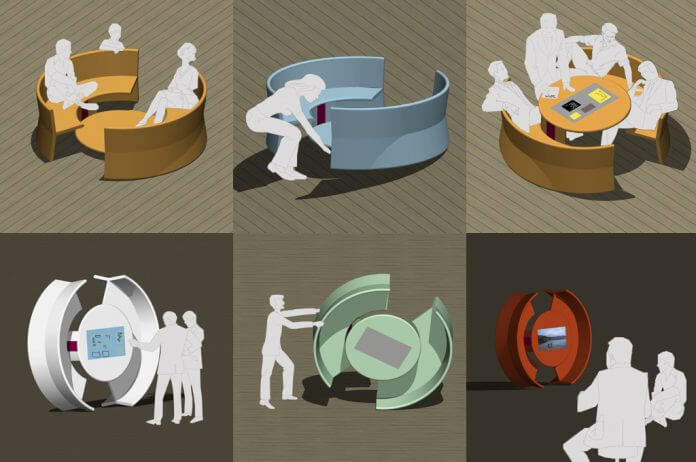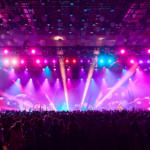Want to get inspired by some next gen meeting space ideas? Even if the designs are a little too wacky for you, the concepts behind the “King Arthur Swing Table” (pictured above) and “The Ring of Communication” (pictured below) have some validity to them.
Here are five best practices to encourage interactivity and collaboration, and to create memorable experiences:
Zoning
Another major consideration is the need to accommodate various behaviours, learning and working styles within the same meeting environment. Generally, the architecture of meeting space provides common areas for lectures, collaboration, networking and entertainment. These activities usually involve high density of people and dynamic communication, and such surroundings may have an adverse effect on some participants. Open spaces are ideal for collaboration but providing niches for private conversations and individual work is also very important. Modern meeting design solutions propose a balanced space with zones for working, networking and privacy.
Flexibility
Research shows that people engage in activities as a result of their surroundings. Experts recommend dynamic environments with sufficient circulation space which allow free movement. Taking it a step further, flexible furniture allows participants to transform and adapt the space to the changing dynamics of the meeting. Modular and manipulative design elements make the space adaptable to different companies, audiences and meeting objectives. Furthermore, appealing to the creative mind of participants can lead to the creation of truly meaningful experiences and much deeper engagement.
Digital technology
Nowadays, the meeting experience is increasingly being shaped by media and technology, and digital devices have become an integral part of all stages of the visitor journey. Advanced display and networking technologies are said to fundamentally change the meeting design, dynamics and culture. Interactive meeting spaces and art installations with cutting-edge technology accommodate the growing participatory culture and the demand for experiences.
Smart materials
In recent years, a new class of materials is gaining popularity. Smart materials include plastics that change shape, paints that conduct electricity, pigments that change colour and fabrics that light up. Smart products are already being used in architecture and interior design, however, introduction to mass markets could have a huge impact on experiential design as they allow participants to come into direct contact with objects and equipment and manipulate their properties through external stimuli. Smart materials have the potential to drastically change the meeting experience as they appeal to a more basic form of interaction between humans and technology.
It’s all about… multi functionality
Meeting space design is inextricably linked to the meeting format and vice versa. In order to inspire involvement, learning, networking, productivity, interaction and creativity, modern meeting planners need to look beyond monofunctional design solutions. The multifunctional design approach is aimed at satisfying the needs of always-on connectivity, various personalities, different generations and workstyles. Moreover, the space should be designed to fit the needs of users, whether privacy, networking or relaxation, and the design should be focused on crafting a holistic experience.
Meeting participants are often people from different walks of life, and therefore, creating the optimal space and design features can be a challenge despite the common purpose of the meeting. The recipe for success: know your audience and try to envision how they would respond to subtle or subconscious cues, but above all, always try to innovate while keeping the greater context in mind so that the meeting achieves its ultimate purpose.
 Design: Kyratzis Athanasios, ubisapdesign
Design: Kyratzis Athanasios, ubisapdesign
Interested in learning more? Read our blog Get Creative…With Meeting Spaces for non-traditional meeting locations, perfect for brainstorming, team building and product launches.





